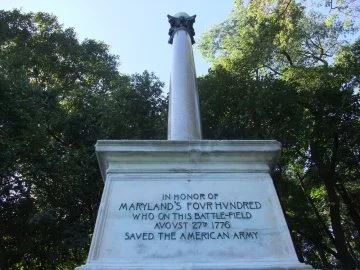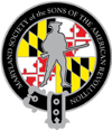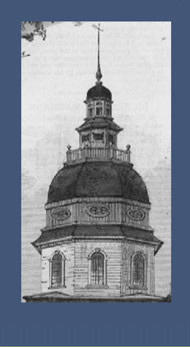Finding the Maryland 400

The battle was a rout, as the experienced British army overwhelmed the inexperienced and poorly- trained Americans, many of whom had only a few months of military service. As the Americans retreated, a portion of the Maryland troops made a series of charges against a much larger British force. These men, now known as the “Maryland 400,” took heavy casualties, but were able to hold the British back long enough to allow the rest of the Continental Army to escape complete destruction.
Finding the Maryland 400 is an effort led by the Maryland State Archives to learn more about these Marylanders, and discover their names, their lives, and their stories. You can read the biographies of the soldiers who fought at the Battle of Brooklyn written so far or check out the blog to read more about the life and times of the Maryland soldiers.
Materials compiled in this document can be used by educators for both Grades 5-12 and K-4.
Materials compiled in this document can be used by educators to fulfill the following United States History Content Standards for Grades 5-12.
Era 3: Revolution and the New Nation (1754-1820s)
Standard 1 : The causes of the American Revolution, the ideas and interests involved in forging the revolutionary movement, and the reasons for the American victory.
Standard 1a : The student understands the causes of the American Revolution
7-12 - Analyze political, ideological, religious, and economic origins of the Revolution. [Analyze multiple causation]
Standard 1b : The student understands the principles articulated in the Declaration of Independence.
9-12 - Draw upon the principles in the Declaration of Independence to construct a sound historical argument regarding whether it justified American independence. [Interrogate historical data].
Standard 1c : The student understands the factors affecting the course of the war and contributing to the American victory.
5-12 - Appraise George Washington’s military and political leadership in conducting the Revolutionary War. [Assess the importance of the individual]9-12 - Analyze the problems of financing the war and dealing with wartime inflation, hoarding, and profiteering. [Identify issues and problems in the past]7-12 -Explain how the Americans won the war against superior British resources. [Analyze multiple causation]
Materials compiled in this document can be used by educators to fulfill the following Maryland Social Studies Standards for Grades 4 and 5.
Grade 4 - Standard 5.0- Topic C. Conflict between ideas and institutions
- Indicator 1. Examine the consequences of interactions among groups and cultures in Maryland
- Objective a. Describe Maryland colonists' reactions to changing economic policies from England using events that led to the American Revolutionary War
- Objectives b. Explain the interactions between colonists and the British during the Pre-Revolutionary period.
- Indicator 4. Analyze how the institution of slavery impacted individuals and groups in Maryland
Grade 5 - Standard 5.0
- Topic C. Conflict between ideas and institutions
- Indicator 1. Analyze the causes of the American Revolution
- Indicator 2. Analyze the effects of the American Revolution
Materials compiled in this document can be used by educators to fulfill the following Maryland Common Core Reading Standards for Grades 6-8:
CCR Anchor Standard #1
- Read closely to determine what the text says explicitly and to make
logical inferences from it; cite specific textual evidence when writing
or speaking to support conclusions drawn from the text.
RH.6-8.1 - Cite
specific textual evidence to support analysis of primary and secondary
sources
CCR Anchor Standard #2
- Determine central ideas or themes of a text and analyze their development;
summarize the key supporting details and ideas.
RH.6-8.2- Determine
the central ideas or information of a primary or secondary source;
provide an accurate summary of the source distinct from prior knowledge
of opinions
CCR Anchor Standard #3 Analyze how and why individuals, events, and ideas develop and interact over the course of text.
RH.6-8.3 Analyze how and why individuals, events, or ideas develop and interact over the course of a text.
CCR Anchor Standard #4
- Interpret words and phrases as they are used in a text, including determining
technical, connotative, and figurative meanings, and analyze how
specific word choices shape meaning or tone.
RH.6-8.4- Determine
the meaning of words and phrases as they are used in a text, including
vocabulary specific to domains related to history/social studies
CCR Anchor Standard #6
- Assess how point of view or purpose shapes the content and style of a text.
RH.6-8.6- Identify
aspects of a text that reveal an author's point of view or purpose
(e.g., loaded language, inclusion or avoidance of particular facts)
RH.6-8.8- Distinguish among fact, opinion, and reasoned judgment in a text
- TITLE: Portrait of Major General Samuel Smith, 1975 CREATOR: Artist Adrian Lamb (1901-1988), after Gilbert Stuart (1755-1828), artists DESCRIPTION: Oil on canvas, 30 x 25" SOURCE:: MSA SC 1545-1031 NOTES:: Samuel Smith (1752-1839) was a captain at the Battle of Brooklyn, later a lieutenant colonel, who held many public offices after the war, including U.S. Senator 1803-1812 and 1822-1833. As major general of the Maryland Militia, he played a key role in the defense of Baltimore against the British in 1814. REPOSITORY: : Artistic Properties Commission, Maryland State Archives, Annapolis, MD
- TITLE: Portrait of Major Mordecai Gist, 1975 CREATOR: Peter Egeli (b. 1934), after Charles Willson Peale (1741-1827), artists DESCRIPTION: Oil on canvas, 30 x 25" NOTES: Mordecai Gist (1742/43-1792) was a major in 1776, and was the Marylanders’ commander in the field during the Battle of Brooklyn. He remained in the army until the war’s end in 1783, rising to brigadier general, and serving with great distinction. Read more about him and this painting here. Source: MSA SC 1545-1066 REPOSITORY: Artistic Properties Commission, Maryland State Archives, Annapolis, MD
- TITLE: Portrait of Lieutenant Levin Winder, n.d. CREATOR: Florence MacKubin (1861-1918), artist DESCRIPTION: Oil on canvas, 30 x 25" NOTES: Levin Winder (1757-1819) rose from lieutenant to lieutenant colonel, and was governor during the War of 1812. SOURCE: MSA SC 1545-1043 REPOSITORY: Artistic Properties Commission, Maryland State Archives, Annapolis, MD
- TITLE:Portrait of Colonel William Smallwood, 1823 CREATOR: Charles Willson Peale (1741-1827), artists DESCRIPTION: Oil on canvas, 29 x 24” NOTES: William Smallwood (1732-1792), a colonel in 1776, and led the Marylanders during the 1776 campaign. He was promoted to major general in the Continental Army, and served as governor of Maryland 1785-1788. SOURCE: MSA SC 1545-1054 REPOSITORY: Artistic Properties Commission, Maryland State Archives, Annapolis, MD
- TITLE: Painting, Battle of Long Island, 1858 CREATOR: Alonzo Chappel (1828-1887), artist DESCRIPTION: Oil on canvas, 27.6 x 30.1 cm NOTES: The stand of the Maryland 400 at the Battle of Brooklyn. Read more about the painting on our Finding the Maryland 400 blog. SOURCE: M1986.29.1 REPOSITORY: Brooklyn Historical Society, New York City, New York
- TITLE: Will of Daniel Bowie DATE CREATED: August 26, 1776 DESCRIPTION: The day before the Battle of Brooklyn, Captain Daniel Bowie, commander of the 4th Company, wrote his will “if I die on the field of battle.” Daniel Bowie was in fact mortally wounded at the battle and died in British captivity. Read more about Daniel Bowie SOURCE: Prince George's County Register of Wills (Wills, Original), Daniel Bowie, 1776, box 12, folder 44, MSA C1327-12. REPOSITORY: Maryland State Archives, Annapolis, MD
- TITLE: Muster Roll, 4th Company, 1st Maryland Regiment, 1776 DESCRIPTION: Record of soldiers attached to the 4th Company, 1st Maryland Regiment. Entries consist of regiment, company, name, rank, enlistment and discharge dates, and remarks. Remarks include dead, killed, prisoners, missing, and deserted. Only 14 out of 65 men survived death or captivity after the battle. SOURCE: MS 1146 REPOSITORY: Maryland Historical Society, Baltimore, MD
- TITLE: “Seventy Dollar Reward” DATE CREATED: December 9, 1777 DESCRIPTION: Desertion ad for Private Samuel Glasgow, 4th Company, 1st Maryland Regiment. SOURCE: Maryland Journal, MSA SC 2830, Microfilm Reel 852 REPOSITORY: Maryland State Archives Special Collections, Annapolis, MD
- TITLE: Letter, William Smallwood to Matthew Tilghman, President of the Council of Safety DATE CREATED: October 12, 1776 DESCRIPTION: Detailed accounts of the regiments actions during the Battle of Brooklyn. Transcription provided. SOURCE: Journal and Correspondence of the Maryland Council of Safety, July 7:December 31, 1776, Archives of Maryland Online, Volume 12, pages 338-343 REPOSITORY: Maryland State Archives, Annapolis, MD
- TITLE: Letter, Sergeant William Sands to his parents in Annapolis, MD DATE CREATED: August 14, 1776 DESCRIPTION: William Sands sends a letter to his parents describing the scene in New York before the Battle of Brooklyn. Sands, a 19-year-old sergeant from Annapolis, was killed in the fighting. Read more about the letter on our Finding the Maryland 400 blog. SOURCE: Dowsett Collection of Sands Family Papers, MSA SC 2095-1-18 REPOSITORY: Maryland State Archives Special Collections, Annapolis, MD
- TITLE: Map, Plan of the attack on the provincial army on Long Island, August 27th 1776. With the draughts of New York Island, Staten Island, and the adjacent part of the continent. CREATOR: John Bowles (1701-1799) DESCRIPTION: Detailed map of the New York region which shows the various placements of Continental and British soldiers. The Marylanders are the first American unit (shown in blue) on the left side of the American line. SOURCE: G3802.L6S3 1776 .P5 REPOSITORY: Library of Congress Geography and Map Division Washington, D.C.
- TITLE: Joseph Marbury's account for supplies and expenses with General Smallwood DATE CREATED: November 1776 SOURCE: Maryland State Papers (Revolutionary Papers) 1776, box 1, folder 35, item 14/30, MSA S997-1 REPOSITORY: Maryland State Archives, Annapolis, MD
- TITLE: Soldier’s Knapsack View 1 , Soldier’s Knapsack View 2 CREATOR: The First Maryland Regiment group of the Continental Line [Revolutionary War re-enactors] DESCRIPTION: Knapsack or haversack with one leather shoulder strap, metal buckles and the outside of the sack painted red with the abbreviation for the 1st Maryland Regiment, I MR, painted on it in white letters. Approximate size is 20” long x 13” high. Reproduced from a diagram and description of the object found here. To learn more about the soldier’s use of the knapsack, read our Finding the Maryland 400 blog post. SOURCE: First Maryland Regiment Collection, MSA SC 1583-4-13 REPOSITORY: Maryland State Archives Special Collections, Annapolis, MD
- TITLE: Map, Plan of the Battle of Long Island and of the Brooklyn Defences, August 27, 1776 CREATOR: Henry P. Johnston, 1878 DESCRIPTION: Map provides details about the placement of Continental and British soldiers, including a timeline of the actions and movements of the various units. SOURCE: Johnston, Henry Philips. The Campaign of 1776 Around New York and Brooklyn. New York: Long Island Historical Society, 1878. Map is an insert in the back of the book.
- TITLE: The Old Line State quarter CREATOR: United States Mint, approved December 1997, Reverse designed by Thomas D. Rogers DESCRIPTION: Seventh coin released in the 50 State Quarters Program and the second released in 2000. Maryland, admitted into the Union on April 28, 1788, themed the coin, The Old Line State. It highlights the Maryland State house and is surrounded by White Oak leaf clusters. To learn more about the nickname and design, read our Finding the Maryland 400 blog post. SOURCE: Authorizing Legislation Public Law 105-124, United States Congress, Washington, D.C.
- TITLE: Memorial for a Commission CREATOR: Edward Edgerly/August 1776 DESCRIPTION: Edward Edgerly explains his military service in the Sixth Company, knows commissions will be available soon and feels he would be a good candidate. To learn more about Edward Edgerly and his son, read our Finding the Maryland 400 blog post. SOURCE: Maryland State Papers, Series A, MSA S1004-1-82. REPOSITORY: Maryland State Archives, Annapolis, MD
Fisher, David Hackett. Washington’s Crossing. Oxford University Press, 2004.
Johnston, Henry Philips. The Campaign of 1776 Around New York and Brooklyn. New York: Long Island Historical Society, 1878.
O’Donnell, Patrick K. Washington’s Immortals: The Untold Story of an Elite Regiment Who Changed the Course of the Revolution. New York: Grove Press, 2016
Tacyn, Mark A. “‘To the End’: The First Maryland Regiment and the American Revolution.” Ph.D. diss, University of Michigan, 1999
Access to materials linked within these document packets is intended for educational and research purposes. The written permission of the copyright owners and/or holders of other rights (such as publicity and privacy rights) is required for distribution, reproduction, or other use beyond that allowed by fair use or other statutory exemptions. The responsibility for making an independent legal assessment and independently securing any necessary rights rests with persons desiring to use particular items in the context of the intended use.
Documents for the Classroom is a collaborative partnership of the Maryland State Archives and the Center for History Education (CHE), University of Maryland Baltimore County (UMBC), and the following sponsoring school systems: Anne Arundel County Public Schools, Baltimore City Public School System, Baltimore County Public Schools, Prince George's County Public Schools, Caroline County Public Schools and Howard County Public Schools.
Other program partners include the Maryland Historical Society, State Library Resource Center/Enoch Pratt Free Library, with assistance from the National Archives and Records Administration and the Library of Congress.
Finding the Maryland 400 is a partnership between the Maryland State Archives and the Maryland Society of the Sons of the American Revolution, studying the First Maryland Regiment. 
© Copyright February 01, 2021 Maryland State Archives

